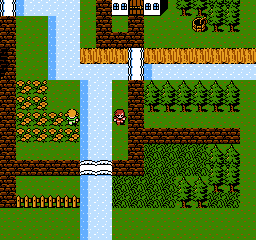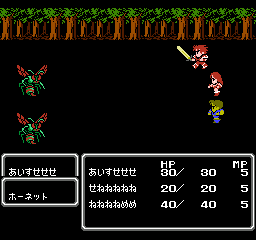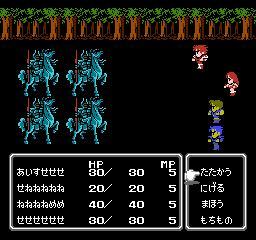Retro Replay Review
Gameplay
Final Fantasy II breaks away from traditional experience-point systems by introducing a usage-based progression model that feels both fresh and unpredictable. As you wield swords against Dark Knights or unleash fireballs on Paramekian soldiers, your characters grow stronger in precisely those actions you perform most. Sustaining hits increases your maximum hit points, while casting spells boosts intelligence at the occasional expense of physical power. This organic approach rewards players for experimenting with different tactics, yet demands careful planning lest a beloved hero become lopsidedly specialized.
Combat itself remains turn-based, but the pacing is brisk and dynamically tied to character speed attributes. You issue commands for each party member — attack, defend, cast magic, or use items — and then observe the round play out. Because weapon proficiencies and spell strength improve through repeated use, encounters never feel stale: you constantly witness your blade-based warriors acquiring deadly precision and your mages harnessing ever more potent incantations. The lack of rigid job classes grants you full freedom to craft a party that suits your personal playstyle.
Outside of battles, exploration and resource management are equally engaging. Towns like Altea or Rosemead offer opportunities to stock up on weapons, armor, and MP-restoring items while inns provide the essential healing breaks between perilous missions. The world map is straightforward but dotted with side paths, secret passages, and optional dungeons that reward curiosity. Whether you’re infiltrating an empire stronghold or rescuing captured allies, each journey segment feels purposeful, underscored by the constant threat of imperial oppression.
Graphics
Visually, Final Fantasy II reflects the pinnacle of the 16-bit era’s artistry. Character sprites are crisp and expressive, each hero and foe distinguished by bold color palettes and clear silhouettes. In battle scenes, the animations for weapon swings and spellcasting are satisfyingly fluid, lending weight to every cut of a blade or flourish of magic. The result is an immersive spectacle that, despite hardware limitations, still resonates with nostalgic charm today.
Environmental design is a standout feature: from the smoldering ruins of Phin to the tranquil forests surrounding Altair, each map tile conveys atmosphere and narrative context. Town interiors bristle with life, populated by merchants, townsfolk, and soldiers whose simple animations hint at thriving communities under threat. Even the stark, monochromatic dungeons maintain a sense of foreboding, their shadowy corridors and flickering torches reinforcing the game’s darker themes.
Special effects — such as the dazzling flares of advanced magicks or the ominous glow of Dark Knight armor — accentuate climactic moments without overwhelming the screen. Menus and UI elements are clean and intuitive, ensuring that weapon upgrades and spell selections remain painless. In sum, the graphical presentation celebrates the strengths of its era while sidestepping any unnecessary clutter.
Story
At the heart of Final Fantasy II lies a narrative of resistance and sacrifice. When the mighty Paramekian Empire annihilates the peaceful realm of Phin, four young heroes must band together and carry their trauma into a broader rebellion. The initial ambush by the Dark Knights sets a somber tone, reminding players that the stakes are high and not all comrades will survive each skirmish unscathed.
Character development stands out as the plot unfolds. Firion emerges as the reluctant leader, driven by duty rather than desire for glory; Maria’s courage shines as she hones her magic to protect innocent villages; Guy’s strength of spirit offers stalwart defense, and Leon’s mysterious disappearance casts a long shadow, motivating the others’ quest. These interwoven arcs lend emotional weight to every confrontation, as you’re not simply chasing high scores but fighting for the fate of friends and countrymen.
The story structure balances linear progression with moments of choice, allowing you to engage in side missions that deepen your understanding of the conflict. Rescuing civilians, thwarting imperial spies, and forging alliances with disparate rebel factions all contribute to a tapestry of desperation and hope. Dialogue is concise yet evocative, and key cinematics — though simple by modern standards — achieve genuine impact when tragedy and triumph collide.
Overall Experience
Final Fantasy II offers a gameplay loop that is both immediately gratifying and surprisingly deep. The freedom to mold your party through skill usage ensures that no two playthroughs feel identical, encouraging experimentation with unconventional builds. Battles remain challenging, particularly in the later chapters, but the satisfaction of overcoming seemingly insurmountable odds never diminishes.
The blend of rich narrative, distinctive graphics, and innovative mechanics produces a timeless adventure that still holds its own against contemporary remasters. While some players may find the lack of a traditional leveling curve disorienting at first, the system’s rewards quickly become clear: every action matters, and every bit of effort is tangibly reflected in heroic progress. Music and sound effects, though not extensively discussed here, further elevate key moments with stirring melodies and ominous flourishes.
For fans of classic JRPGs and newcomers seeking a slice of video game history, Final Fantasy II remains a compelling experience. It challenges conventions, tugs at the heartstrings, and delivers tactical depth that rewards dedication. Whether you’re venturing into the overworld to challenge Dark Knights or delving into the enigmatic Wellspring of Silence, this isn’t just a game about defeating an empire — it’s a testament to the enduring power of courage, camaraderie, and sacrifice.
 Retro Replay Retro Replay gaming reviews, news, emulation, geek stuff and more!
Retro Replay Retro Replay gaming reviews, news, emulation, geek stuff and more!








Reviews
There are no reviews yet.